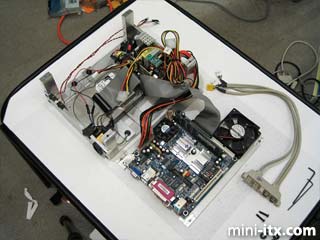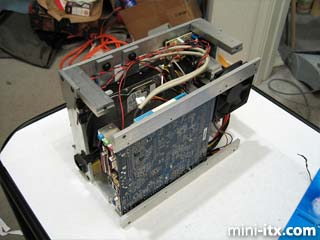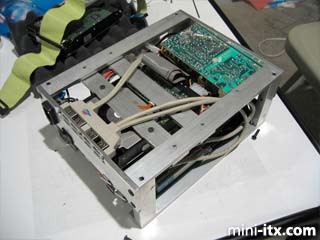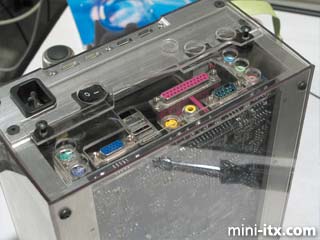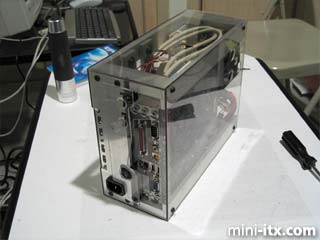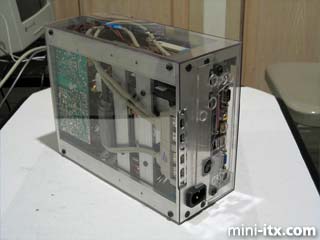Posted on January 19, 2004
The two halves fit together tightly, although there is good clearance and airflow around everything. Without ductwork, I wouldn't want to restrict airflow any more than it is already.
The additional USB and Firewire ports mounted as they are on the outer edge of the case is another improvised design element. I was lucky in that they just barely fit. However, I am limited to hard disks that have an open sunken front. Some hard disks are squared off at the front end. These would not fit.
There are three polycarbonate panels comprising the front. One on the bottom supports the I/O plugs as the screws run through counterbored holes. The next panel is cosmetic to make the front flush with the rest of the case. And the last, uppermost panel, guards the master power switch and the two snap switches that are for power and reset. These are all held together with two machine screws and four rubber washers. Again, this was an improvised solution. I originally wanted to have switches completely recessed into the aluminum, obviating the need for a front panel of this complexity.
The final product isn't perfect. But it's the first computer I've built and the third project with machine tools. After I had finished the aluminum frame and had the computer booting and running, for a short while I considered making the outer covering panels of heavy cardboard. I was so tired. I'm glad that I stuck it out and used polycarbonate. The fit of the panels is tight. The top, bottom, and rear panels are held in by friction only. The front and side panels are held in by screws. Note there are two large holes in the top for exhausting warm air. The five holes in the side are for intake using the power supply fan. So the case operates under positive pressure, the opposite of usual, again suited to Borg technology.
Conclusion
If I could do it over, I'm not sure I would! An off-the-shelf solution is very functional and much cheaper. There are attractive commercial alternatives. The Borg Appliance is heavily overengineered mechanically yet not really strong enough to be considered ruggedized in my view. There is a lot of merit in conventional sheet metal construction. But if coolness weren't important, probably all desktop computers would be generic beige PC clones.
 |
 |
 |
Quick Links
Mailing Lists:
Mini-ITX Store
Projects:
Show Random
Accordion-ITX
Aircraft Carrier
Ambulator 1
AMD Case
Ammo Box
Ammo Tux
AmmoLAN
amPC
Animal SNES
Atari 800 ITX
Attache Server
Aunt Hagar's Mini-ITX
Bantam PC
BBC ITX B
Bender PC
Biscuit Tin PC
Blue Plate
BlueBox
BMW PC
Borg Appliance
Briefcase PC
Bubbacomp
C1541 Disk Drive
C64 @ 933MHz
CardboardCube
CAUV 2008
CBM ITX-64
Coelacanth-PC
Cool Cube
Deco Box
Devilcat
DOS Head Unit
Dreamcast PC
E.T.PC
Eden VAX
EdenStation IPX
Encyclomedia
Falcon-ITX
Florian
Frame
FS-RouterSwitch
G4 Cube PC
GasCan PC
Gingerbread
Gramaphone-ITX-HD
GTA-PC
Guitar PC
Guitar Workstation
Gumball PC
Hirschmann
HTPC
HTPC2
Humidor 64
Humidor CL
Humidor II
Humidor M
Humidor PC
Humidor V
I.C.E. Unit
i64XBOX
i-EPIA
iGrill
ITX Helmet
ITX TV
ITX-Laptop
Jeannie
Jukebox ITX
KiSA 444
K'nex ITX
Leela PC
Lego 0933 PC
Legobox
Log Cabin PC
Lunchbox PC
Mac-ITX
Manga Doll
Mantle Radio
Mediabox
Mega-ITX
Micro TV
Mini Falcon
Mini Mesh Box
Mini-Cluster
Mobile-BlackBox
Moo Cow Moo
Mr OMNI
NAS4Free
NESPC
OpenELEC
Osh Kosh
Pet ITX
Pictureframe PC
Playstation 2 PC
Playstation PC
Project NFF
PSU PC
Quiet Cubid
R2D2PC
Racing The Light
RadioSphere
Restomod TV
Robotica 2003
Rundfunker
SaturnPC
S-CUBE
SEGA-ITX
SpaceCase
SpacePanel
Spartan Bluebird
Spider Case
Supra-Server
Teddybear
Telefunken 2003
TERA-ITX
The Clock
ToAsTOr
Tortoise Beetle
Tux Server
Underwood No.5
Waffle Iron PC
Windows XP Box
Wraith SE/30
XBMC-ION

